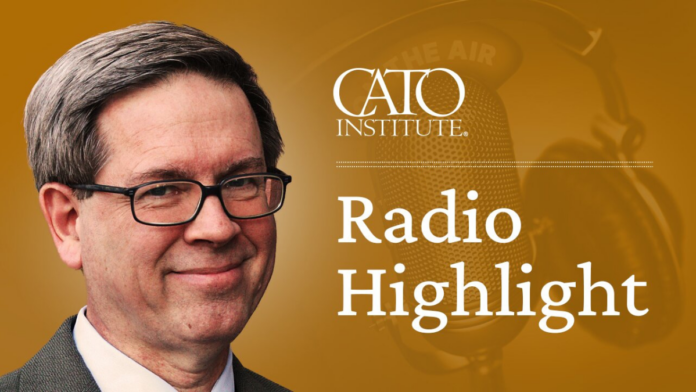
The Congressional Review Act (CRA) is a buzzy term that has been making the rounds in the political press lately. After five CRA resolutions sailed through the House – two are awaiting the president’s approval now – speculation and confusion abound as to what the law actually is.
Last week, Western Wire published an analysis on the Senate’s statutory authority to use the CRA.
This week, Western Wire checked in with Beltway experts on why the CRA is being used in Congress now, how the process works and whether it really can repeal late-term Obama administration regulations.

Walter Olson, senior fellow at the Cato Institute’s Center for Constitutional Studies (photo credit: Cato Institute).
Part of the confusion stems from the fact that the 1996 law has only been successfully used once. So why are we seeing a flurry of CRA activity now all of a sudden? Walter Olson, Senior Fellow at Cato Institute’s Center for Constitutional Studies, gave two answers.
“Most likely because the executive during those periods either 1) was not issuing many regulations unwelcome to Congress, or 2) could successfully wield a veto to defend regulations, making a CRA resolution a waste of effort,” Olson explained in an email.
“Now that the veto threat has largely ended, there is every reason for Congress to act vigorously and promptly against unwelcome regulations subject to overturn under the CRA,” he continued.
In other words, because the legislative and executive branches of government are rarely held by one party, opportunities to use the CRA had been limited until now.

Todd Gaziano, senior fellow in constitutional law at the Pacific Legal Foundation (photo credit: Pacific Legal Foundation).
That said, “the CRA has been on the books for over 20 years,” Pacific Legal Foundation constitutional law fellow Todd Gaziano pointed out. The law “could have been used by Obama and the Democratically controlled Congress (both Houses) in 2009 if they thought the George W. Bush administration’s regulations were abusive or ill conceived.”
As Western Wire explained earlier this week, liberals, including former Senate Majority Leader Harry Reid (D-Nev.), hailed the use of the CRA for Bush-era regulations back in 2008, when Barack Obama became the nation’s 44th president.
For the groups supporting the regulations that now face a CRA demise, however, previous Democratic enthusiasm for the CRA has not stopped them from crying foul.
Earthjustice, a California-based environmental group, called the CRA “an undemocratic and rarely used backdoor tactic.” Union of Concerned Scientists, a Cambridge, Mass.-based advocacy group, called it “an obscure, radical, and rarely used congressional trick” and a “radical maneuver.”

Clyde Wayne Crews, Vice President for Policy at the Competitive Enterprise Institute (photo credit: Competitive Enterprise Institute).
But the CRA actually originated from attempts to “resolve a question of illegitimacy,” explained Clyde Wayne Crews, Vice President for Policy at the Competitive Enterprise Institute. For decades,
Congress had used the legislative veto – including one-house, two-house and even committee vetoes – to nullify actions by executive branch agencies. The practice was eventually found unconstitutional by the Supreme Court in 1983.
“It used to be the one house would attempt to eliminate regulations, and that violated the presentment clause,” Crews said. “So now, with the Congressional Review Act, if a resolution of disapproval is passed, the president would need to sign it. Which, of course, is the right way to do things.”
“People who don’t like that regulations are being overruled by Congress,” Gaziano added, “should not knowingly misrepresent what the CRA provides or its democratic legitimacy.”
Groups alarmed at Congress’ efforts to roll back Obama-era regulations may have good reason to despair, for CRA resolutions are exempt from the Senate’s practice of lengthy debate and deliberation – and the age-old tactic of chewing up time in the legislative calendar.
The language of the text itself “could not be more explicit,” said Olson, referring to a section that prevents the use of delay motions, including “[a]n amendment to, or a motion to postpone, or a motion to proceed to the consideration of other business, or a motion to recommit the joint resolution.”
“The drafters of the CRA foresaw the possibility of obstructionism and included the tools to limit debate,” Olson explained.
In addition to capping debate time in the Senate at 10 hours, the law also allows a simple majority to curtail debate even further. A “shorter period of debate is perfectly okay if that is what the body decides,” said Olson.

Daren Bakst, research fellow at the Heritage Foundation (photo credit: Heritage Foundation).
As long as opponents of CRA resolutions are allowed half the debate time, floor discussions could take substantially less than 10 hours. “The truth is that all of that can be lower,” Daren Bakst, research fellow at the Heritage Foundation’s Institute for Economic Freedom and Opportunity, said in an interview. “You could have one hour, or two hours, of debate, and then just divide it equally.”
Furthermore, because CRA-vulnerable regulations are familiar subjects – many had been examined at congressional hearings during the rulemaking process – senators may be ready to vote as soon as the resolution hits the floor.
For these regulations, Gaziano explained, “much more has been written on their final text in the press before the vote to disapprove them, and many more constituents have often weighed in on them, than the text of most statutes Congress votes on. So senators can be well prepared to vote on whether to disapprove a rule before debate begins.”
“Although the Senate likes to think of itself as the greatest deliberative body,” he continued, “I doubt long floor debate on disapproving a regulation is as productive or persuasive as that on legislative amendments, and few amendments are debated for more than an hour.”
All in all, the scholars, analysts and experts told Western Wire they see the recent use of the CRA as an encouraging and refreshing sign of Congress exercising its authority, and responsibility, to hold executive agencies accountable.
“There’s a particularly important need to use the CRA,” said Bakst, “because the Obama administration and many agencies have gone way beyond their statutory authority, and it’s important for Congress to get back its power, its own lawmaking power. The powers [that are] used by agencies, all that power is derived from Congress itself.”
“The revival of Congressional activity under the CRA is a welcome development and shows that Congress is taking seriously its responsibilities both as ultimate lawmaker and in oversight of federal agencies,” said Olson.
